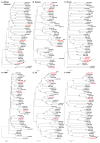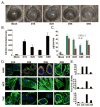Recombination of the epsilon determinant and corneal tropism: Human adenovirus species D types 15, 29, 56, and 69
- PMID: 26343864
- PMCID: PMC4619159
- DOI: 10.1016/j.virol.2015.08.018
Recombination of the epsilon determinant and corneal tropism: Human adenovirus species D types 15, 29, 56, and 69
Abstract
Viruses within human adenovirus species D (HAdV-D) infect epithelia at essentially every mucosal site. Hypervariable loops 1 and 2 of the hexon capsid protein contain epitopes that together form the epsilon determinant for serum neutralization. We report our analyses comparing HAdV-D15, 29, 56, and the recently identified type 69, each with highly similar hexons and the same serum neutralization profile, but otherwise disparate genomes. Of these, only HAdV-D type 56 is associated with epidemic keratoconjunctivitis (EKC), a severe infection of ocular surface epithelium and underlying corneal stroma. In the mouse adenovirus keratitis model, all four viruses induced inflammation. However, HAdV-D56 entry into human corneal epithelial cells and fibroblasts in vitro dramatically exceeded that of the other three viruses. We conclude that the hexon epsilon determinant is not a prime contributor to corneal tropism.
Keywords: Adenovirus; Epidemic keratoconjunctivitis; Homologous recombination; Keratitis.
Copyright © 2015 Elsevier Inc. All rights reserved.
Figures




References
-
- Alba R, Bradshaw AC, Parker AL, Bhella D, Waddington SN, Nicklin SA, van Rooijen N, Custers J, Goudsmit J, Barouch DH, McVey JH, Baker AH. Identification of coagulation factor (F)X binding sites on the adenovirus serotype 5 hexon: effect of mutagenesis on FX interactions and gene transfer. Blood. 2009;114:965–971. - PMC - PubMed
-
- Blair GE, Dixon SC, Griffiths SA, Zajdel ME. Restricted replication of human adenovirus type 5 in mouse cell lines. Virus Res. 1989;14:339–346. - PubMed
-
- Butt AL, Chodosh J. Adenoviral keratoconjunctivitis in a tertiary care eye clinic. Cornea. 2006;25:199–202. - PubMed
-
- Chintakuntlawar AV, Astley R, Chodosh J. Adenovirus type 37 keratitis in the C57BL/6J mouse. Invest Ophthalmol Vis Sci. 2007;48:781–788. - PubMed
Publication types
MeSH terms
Substances
Grants and funding
LinkOut - more resources
Full Text Sources
Other Literature Sources

